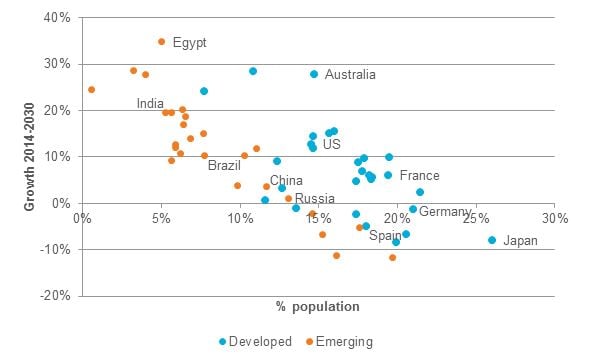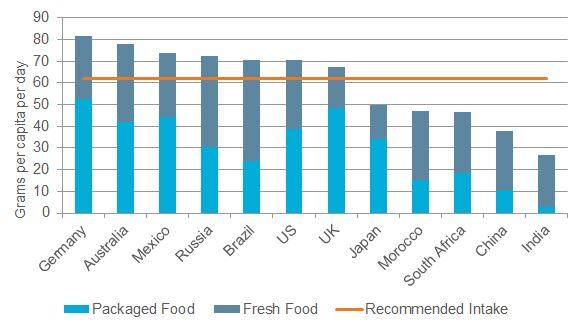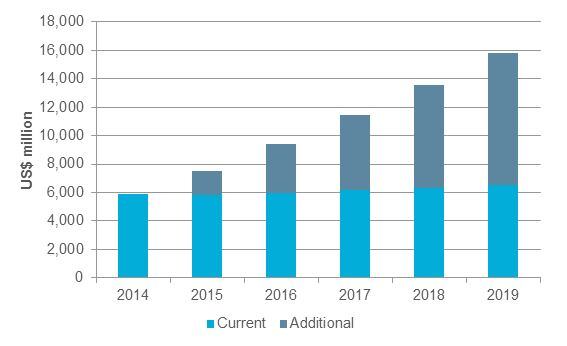Walk into a supermarket in Western Europe or North America and you’ll find entire shelves dedicated to children’s food and drink products: Yoghurts, breakfast cereals, bread, snacks, ready meals, confectionery, soft drinks – the list is seemingly endless.
Have a look for products targeted at the ageing population and you’ll be hard pressed to find anything, despite there being three times as many people aged 65+ compared to 0-4 years in these two regions. Sales of supplement nutrition drinks, which are mostly positioned towards the elderly, were worth US$1.4 billion (€1.26bn) in 2014 in Western Europe and North America, but this is dwarfed by the size of the baby food industry, which was worth US$14.2bn (€12.84bn).
While essential for all, protein is particularly important for the young, as they grow, and for the elderly, to prevent the loss of muscle mass and strength. With the high protein trend moving to almost every category imaginable – ice cream, cookies, breakfast cereals and crisps – manufacturers could avoid saturating the market by targeting high protein products at the ageing population in particular, where the nutritional need is strong and disposable incomes are relatively high.
In 2014, there were 619 million people aged 65+ and by 2030 this is expected to increase by 75% to reach 1.1 billion, representing 13% of the total global population.
Countries in the Middle East and Africa are expected to see some of the highest forecast elderly growth rates and two fifths of those aged 65+ are expected to live in China and India alone by 2030.
However, it is developed countries where older populations represent the largest proportion of the total population, and with disposable incomes in Western Europe and North America being higher, it is these regions where manufacturers could take advantage of the 137m potential consumers with an age-specific product.
Population Aged 65+: Proportion of Total Population (2014) vs Forecast Growth Rates (2014-2030)

The daily protein requirements for a healthy adult weighing 75kg is around 62g a day. When calculating the amount of protein purchased not just from packaged products, but from fresh food too, Passport Nutrition data shows that many countries more than satisfy these requirements already, with purchasing well over the recommended amount.
In emerging markets, including China, India and Brazil, fresh food – which includes fresh meat, fish and eggs – is still the predominant source of protein in the diet, although the proportion is expected to decline as penetration and availability of packaged products increases, especially in rural areas of these countries.
Protein Purchased from Packaged Food vs Fresh Food by Country 2014

While the general population might not necessarily need to consume more protein, as people age, the risk of losing muscle mass and strength increases and a high protein diet is thought to mitigate these effects.
While nobody wants to be told they’re old, when marketed in the right way, ageing-specific products can be a success; anti-ageing skincare products have grown by US$10bn (€9.05bn) in the last decade to reach US$25.8bn (€23.34bn) in 2014 and is one of the fastest growing categories in the beauty industry.

It can be done in food too; Cal-in+, a brand from Yoplait and General Mills, is a yoghurt that contains vitamin D and calcium for strong bones and although it doesn’t explicitly target the ageing, is marketed to protect against age-associated losses in bone mass. Sales of the brand have increased by 18% in Western Europe over the last two years to reach US$10.5m (€9.5m) in 2015 - with astute marketing and communication there is clear potential for foods to be positioned as “healthy-ageing”.
Dairy is the natural home of high protein products and there has been a lot of development in the category related to protein, with mainstream brands like Tru Moo and Nesquik launching high protein variants, or marketing their products as being high in protein.
If over-65s in North America and Western Europe were to spend US$5 (€4.52) a month on a high protein milk drink targeted at healthy ageing over the next five years, starting with an extra US$1 (€0.9) in 2015 and US$5 (€4.52) in 2019, the market would more than double in size to reach US$16 (€14.47bn) by 2019.
Market Potential for Flavoured Milk Drinks to Ageing Populations in North America and Western Europe 2014-2019

Given that the current per capita expenditure on flavoured milk drinks in 2014 was US$9 (€8.14) in North America and US$4 (€3.62) in Western Europe annually, it’s very unlikely that the market will follow this ‘US$5 (€4.52) a month’ trajectory over the next five years.
However it does highlight that there is great potential and a clear gap in the market for high protein products for healthy ageing; while this gap might not be easy to bridge in terms of marketing and communication, manufacturers should consider targeting high protein products at the ageing population, where nutritional requirements are greatest.
